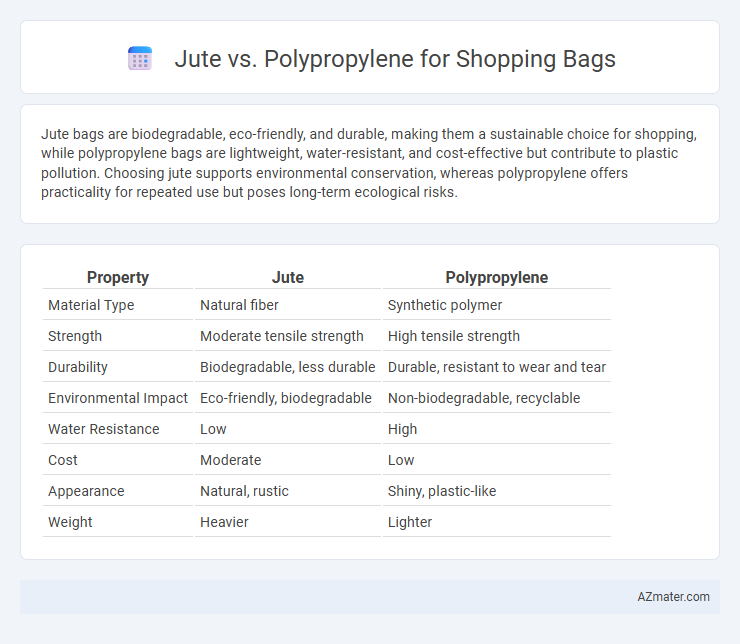Jute bags are biodegradable, eco-friendly, and durable, making them a sustainable choice for shopping, while polypropylene bags are lightweight, water-resistant, and cost-effective but contribute to plastic pollution. Choosing jute supports environmental conservation, whereas polypropylene offers practicality for repeated use but poses long-term ecological risks.
Table of Comparison
| Property | Jute | Polypropylene |
|---|---|---|
| Material Type | Natural fiber | Synthetic polymer |
| Strength | Moderate tensile strength | High tensile strength |
| Durability | Biodegradable, less durable | Durable, resistant to wear and tear |
| Environmental Impact | Eco-friendly, biodegradable | Non-biodegradable, recyclable |
| Water Resistance | Low | High |
| Cost | Moderate | Low |
| Appearance | Natural, rustic | Shiny, plastic-like |
| Weight | Heavier | Lighter |
Introduction: Jute vs Polypropylene Shopping Bags
Jute shopping bags are biodegradable, eco-friendly, and made from natural plant fibers, making them a sustainable choice for environmentally conscious consumers. Polypropylene shopping bags, composed of synthetic plastic, offer durability, water resistance, and cost-effectiveness but pose environmental challenges due to their non-biodegradable nature. The choice between jute and polypropylene bags hinges on prioritizing sustainability versus utility and cost efficiency.
Material Composition and Properties
Jute shopping bags are made from natural vegetable fibers derived from the jute plant, offering biodegradability, breathability, and strength, making them environmentally friendly and durable for multiple uses. Polypropylene bags consist of synthetic polymer fibers, characterized by high tensile strength, water resistance, and lightweight properties, which contribute to their cost-efficiency and reusability. The natural composition of jute makes it more sustainable and compostable, whereas polypropylene's plastic base leads to longer decomposition times but enhanced moisture resistance.
Environmental Impact and Sustainability
Jute shopping bags offer a biodegradable and renewable alternative to polypropylene bags, significantly reducing plastic pollution and landfill waste. Jute cultivation enhances soil health and has a low carbon footprint, whereas polypropylene bags, made from non-renewable fossil fuels, contribute to greenhouse gas emissions and persistence in the environment. Choosing jute bags supports sustainable agriculture and circular economy goals, while polypropylene bags pose challenges for recycling and long-term environmental impact.
Durability and Strength Comparison
Jute shopping bags offer natural fiber strength and are biodegradable but generally have lower tensile strength and durability compared to polypropylene bags, which are made from synthetic plastic fibers known for high resistance to wear and tear. Polypropylene bags excel in water resistance and tensile strength, lasting through heavy use and exposure to moisture, unlike jute bags that may degrade faster in damp conditions. The choice between jute and polypropylene depends on priority for eco-friendliness or long-lasting performance, with polypropylene providing superior durability and strength in repeated, heavy shopping scenarios.
Cost Analysis: Jute vs Polypropylene
Jute bags typically involve higher upfront costs due to the natural fiber processing and eco-friendly manufacturing methods, whereas polypropylene bags are generally cheaper to produce thanks to synthetic materials and mass production efficiency. The durability and reusability of jute bags can lead to long-term cost savings despite the initial investment, while polypropylene bags might require more frequent replacement due to lower environmental resistance. Cost analysis favors polypropylene for low-cost, disposable options, but jute offers a more sustainable and value-driven choice for consumers prioritizing environmental impact and durability.
Reusability and Maintenance
Jute shopping bags offer exceptional reusability due to their natural fiber strength and durability, making them ideal for multiple uses without tearing or significant wear. Polypropylene bags are also reusable but tend to degrade faster under repeated use and exposure to sunlight, reducing their lifespan compared to jute. Maintenance for jute bags involves gentle cleaning and drying to prevent mold, while polypropylene bags require simple wiping or washing, although polypropylene is more resistant to water and stains.
Biodegradability and End-of-Life Disposal
Jute shopping bags are composed of natural fibers that are fully biodegradable and decompose within a few months when exposed to composting conditions, making them environmentally sustainable. Polypropylene bags, derived from petrochemicals, are non-biodegradable and can persist in landfills for decades, contributing to long-term plastic pollution. Proper end-of-life disposal for jute bags involves composting or organic recycling, whereas polypropylene bags require specialized recycling processes that are often limited in availability.
Aesthetic Appeal and Customization Options
Jute shopping bags offer a natural, rustic aesthetic with a coarse texture and earthy tones that appeal to eco-conscious consumers, while polypropylene bags provide a sleek, smooth finish available in vibrant colors and prints. Customization options for jute are typically limited to screen printing and embroidery, emphasizing artisanal and organic branding, whereas polypropylene allows for extensive digital printing and heat transfers, enabling high-detail graphics and branding versatility. Both materials support brand visibility, but polypropylene's flexibility in design makes it ideal for intricate logos and multicolor patterns.
Consumer Preferences and Market Trends
Consumer preferences increasingly favor jute shopping bags due to their eco-friendly, biodegradable properties and natural texture, appealing to sustainability-conscious buyers. Market trends indicate a rising demand for polypropylene bags attributed to their durability, cost-effectiveness, and water resistance, making them popular in mass retail and promotional uses. The shift towards green consumerism drives growth in jute bags, while polypropylene maintains a strong presence in markets prioritizing affordability and practicality.
Conclusion: Choosing the Right Shopping Bag Material
Jute bags offer eco-friendly, biodegradable properties with natural durability, making them ideal for sustainable shopping practices. Polypropylene bags provide lightweight, water-resistant, and cost-effective benefits, suitable for repetitive use and mass distribution. Selecting between jute and polypropylene depends on prioritizing environmental impact versus affordability and practicality for everyday shopping needs.

Infographic: Jute vs Polypropylene for Shopping bag
 azmater.com
azmater.com